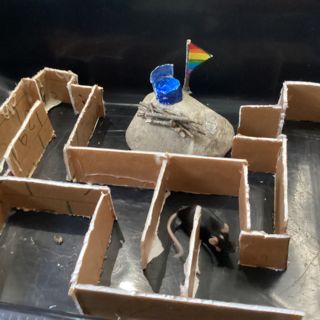MINT: Students Experiment (SchüEx)

Fish and Rock’n‘Roll
The "Schüler experimentieren" (Students Experiment) workshop, which follows the German model of "Jugend forscht" and the "Science Fair" at American schools, has generated strong interest from our students in grades 4-7 for many years.
In mixed-age teams, they work for an entire year on their own research questions, develop their own experiments and equipment, document their results and draw conclusions. In the process, they learn the importance of solving challenges cooperatively.
There were exciting projects again this year. Some examples:
A group of the youngest AG members documented the progress made on the reintroduction of native bird species on our school campus. They observed a pair of Red-shouldered Hawks on their "nuptial flight", the raising of five young Bluebirds and Tree Swallows, and learned all about Barred Owls, for which they installed a nesting box.
The 5th graders studied the effect of colored light on the growth of fire beans and found that they thrive best in green light and less well in blue or red.
The "Gerbil Group" wanted to find out which surface our school gerbil, "Toffi", prefers and were astonished to discover that, despite many natural offerings, she was most often and longest found on Styrofoam!
A 6th grader group investigated whether and how fish in the experiment, Ballon Mollies, react to music. For this purpose, they set up an aquarium, which now decorates the biology room. Unfortunately, the "Queen" song "We will rock you" did not go over well with the fish. Oscar, one of the Mollies, got nauseous every time and all the others hid when the music was loud. Despite weekly sound waves, overall, the fish felt very comfortable in the aquarium and even had offspring twice!
Several teams worked with the three school mice; Holly, Bernhard and Nugget (who are all females, by the way). They built various mazes and an elaborate parkour and found out that Holly is smarter than Bernhard.
Finally, a team of 6th and 7th graders found out that borax is best for growing crystals, while salt and sugar are less suitable.
At the final event on June 16, all participants successfully presented their results, and each received a certificate and their first MINT booklet. This booklet documents all the STEM activities that the students have successfully completed during their school career and converts those into points. In addition to good performance in the STEM subjects, these points count toward earning a STEM certificate in grade 12.
We are proud to have been able to award this certificate to a (now former) student of GISW this year, Maya K., who once started her research in a Schüex-AG.
Congratulations!
Nicole Bankert and Steffi Colopy
AG supervisors















